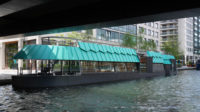Arguably the most elaborate Hindu temple in the United States, the $8 million white granite San Marga Iraivan Temple, designed by V. Ganapati Sthapati for the Saiva Siddhanta Church, is intended to last 1,000 years. Construction began in 2001 and is scheduled to be finished in 2012.
Hundreds of temples serve the 2.2 million Hindus living in the United States, but the Iraivan (meaning "He who is worshipped") Temple is the only one known to be built without modern equipment. Since 1990, 75 sculptors have been working in Bangalore, India, to create the building’s intricately carved stone blocks, which are then shipped to the Kauai monastery 8,000 miles away.
Once they arrive, the blocks—some weighing as much as 4,000 pounds—are physically shoved into place by nine local stonemasons who work full-time on the project. Six Saivite monks also are helping build the structure. "We have the last team capable of building this way," says Paramacharya Palaniswami, a Hindu monk who has lived at the monastery since its founding in 1970.
When completed, the building will measure 71 feet wide by 179 feet deep, and will stand 35 feet from its base to its gold-leafed capstone. The 4-foot thick foundation was formed by a single pour of crack-free, 7000 psi fly-ash concrete and required 108 cement trucks. It was the first, non-laboratory single pour performed since Roman times, according to the foundation's designer Kumar Mehta, a materials scientist at UC Berkeley.
Palaniswami says the temple is the fulfillment of his guru's vision. The monastery’s founder, Satguru Sivaya Subramuniyasami, whom the monks call “Gurudeva,” reported seeing the Hindu god Siva walking on the grounds in February 1975. "He took it as a sign,” says Palaniswami, “that Siva wanted to live here." Gurudeva, who died in 2001, outlined three parameters for the temple: that it last 1,000 years, follow traditional design according to the Saiva Agamas (popular Hindu scriptures), and be built without machinery.
Palaniswami says many Hindus in India are happy to see their traditional building heritage take root in the West. "In the West, we build fast and cheap. We don't tend to look upon our architecture as holy," he says. "This is a holy place. We're building a home for Siva."







